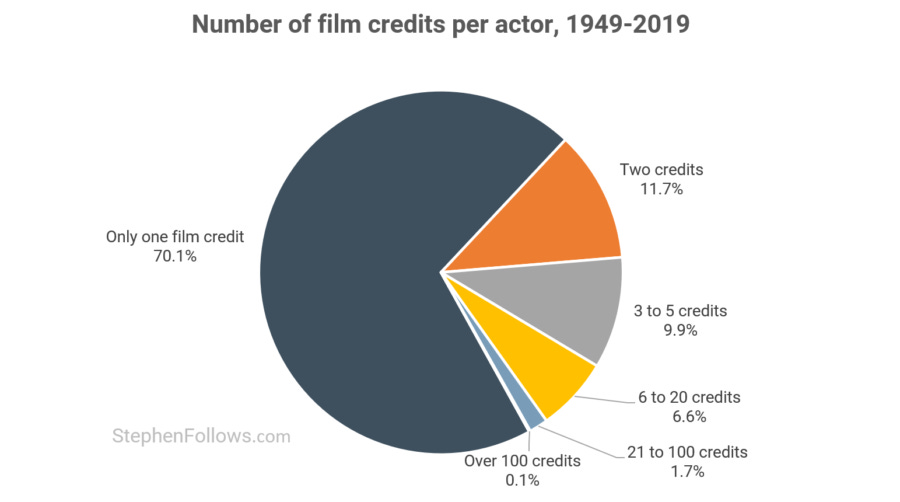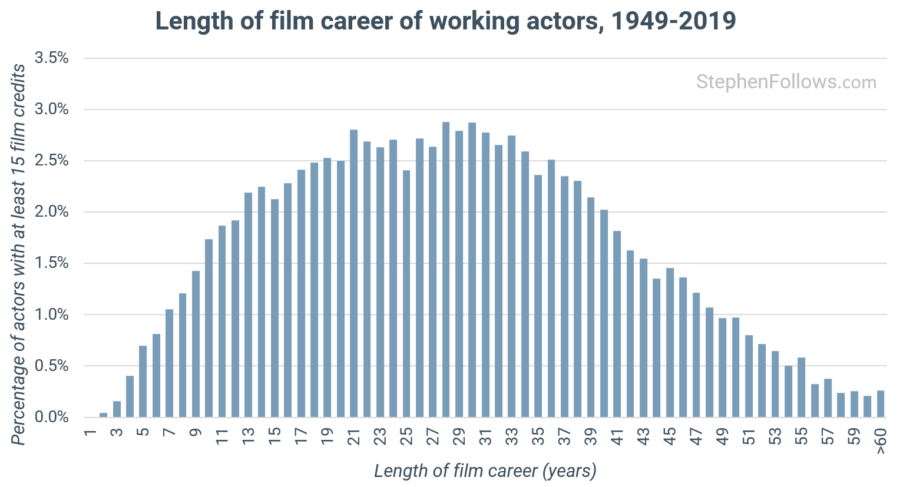How long is the typical film actor's career?
There are a number of ways an actor may assess how their career is going.
They could consider their income, fame, power, time employed, quality of roles/movies, how closely it aligns with their ideal career or if it enables them to buy as many Mongolian dinosaur bones as they feel they need.
Another metric is the number of films they have been hired to appear in. And it's this we're looking at today, thanks to a reader who got in touch to ask about the length of acting careers.
I built a dataset of all films made since 1949 and honed in on the acting credits. My methodology and more explanation can be found at the end of the article. For brevity's sake, I'll just say that this is looking at the credits of the 44,639 actors who have appeared in at least 15 feature films over the 71-year period I studied.
How many films does a working actor appear in?
As with many aspects of the film industry, the acting world is dominated by short-term participants. I've previously shown how only a third of directors direct a second movie and a third of writers are credited more than once. The acting world is no different.
70.1% of people who received one acting credit on a movie never received a second. Only 8.4% received more than five credits and fewer than 1% received more than 30.
The Guinness World Record for the greatest number of screen credits is currently held by Brahmanandam. At the time of writing, IMDb credits him with 1,164 acting roles, although I am sure this is already out of date.
How long is the average film career?
By looking at the time between an actor's first and last film credit, we get a measure of how long their career was. This isn't tracking how illustrious, industrious or calumnious their career was/ is, just for how long they kept turning up on the big screen.
Note: For this part of the research, I focused on actors who have not had a screen credit since 2010 in order to measure completed careers. I.e. if an actor had worked more recently then it is too early to say how long their career was as it is still active.
The average career length was 28.4 years, although there was a wide spread of careers. 46.5% of actors had a film career of between 20 and 40 years.
How do the film careers of men and women differ?
As well as looking at the overall answer, I also subdivided the actors by their public gender (see more on this in the Notes). Across the dataset, just 30.5% of actors were women.
How old are actors when they receive their first on-screen film credit?
In previous research, I have shown that men and women have very different experiences of the acting profession. Whilst there's no doubt that all actors face pressure to appear youthful, women are under more close scrutiny and are punished for ageing far more than men. We see this reflected in the differences between how old actors are when they receive their first film credit.
The average male actor is 30.5 years old when their first film is released, compared to 25.9 years old for women.
Given that women live longer than men, we might expected to see female actors having a higher average age at the release of their final movie. Not so. The average male actor is 61.4 when his final film is released, compared to 55.8 for women.
Notes
The raw data for today's research came from IMDb, Wikipedia and The Numbers / Opus Data. It looks at appearance credits on all feature films made between 1949 and 2019, inclusive.
Age relates to the number of years between their year of birth and the year the film was first released to the public. Given that films can take a year or two to create (more data on that here), their age when shooting the movie will be slightly lower. I was able to find a year for birth for 69% of my actors. I did not take account of exact release days or month, nor days or months of birth due to a lack of data.
I removed any people whose appearance as 'themself' accounted for over half their film credits. These people are typically politicians, music stars and sports personalities. I also didn't count an appearance as 'themself' or within archive footage as an acting credit, as otherwise, it elongated an actor's career, often past death and would have included Adolf Hilter as a much-in-demand screen performer.
I have opted to use the word "actor" to apply to people of all genders. I have split the gender stats into two categories as this reflects the way data has been captured over the period I studied. In the future, there may more nuanced databases which capture gender fluidity and non-binary identities, but until then we're left with a binary approach. I used the gender the person currently publically identifies as. I have referred to the two studied genders as "men" and "women" unless grammatically incorrect to do so.
The original question this research is responding to was about working actors and so I had to create some kind of threshold. If we open it up to anyone who has been credited as a cast member in a movie then it's just over 1.7 million people. Therefore, I opted to focus on people who had received at least 15 feature film acting credits between 1949 and 2019, inclusive.
This is a quick research project and so I've skipped over a few factors which a deeper study may be able to take account of. For example, the dataset includes cameos (if they have at least 15 total credits). It also applies equal weight to all credits, no matter the size of the film or the role the actor is playing.
It's worth noting that an actor may have a successful career away from film, such as on the stage or on television. Their occasional forays onto the big screen would show up here but wouldn't reflect the totality of their acting career.








